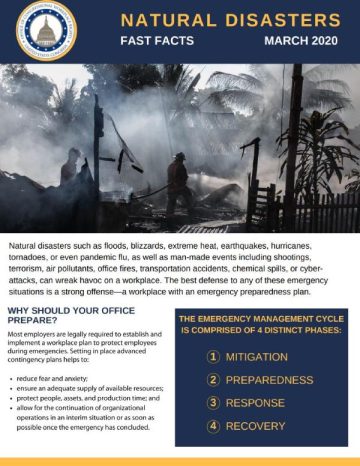Natural disasters such as floods, blizzards, extreme heat, earthquakes, hurricanes, tornadoes, or even pandemic flu, as well as man-made events including shootings, terrorism, air pollutants, office fires, transportation accidents, chemical spills, or cyberattacks, can wreak havoc on a workplace. The best defense to any of these emergency situations is a strong offense—a workplace with an emergency preparedness plan.
WHY SHOULD YOUR OFFICE PREPARE?
Most employers are legally required to establish and implement a workplace plan to protect employees during emergencies. Setting in place advanced contingency plans helps to:
- reduce fear and anxiety;
- ensure an adequate supply of available resources;
- protect people, assets, and production time; and
- allow for the continuation of organizational operations in an interim situation or as soon as possible once the emergency has concluded.
THE EMERGENCY MANAGEMENT CYCLE IS COMPRISED OF 4 DISTINCT PHASES:
- MITIGATION
- PREPAREDNESS
- RESPONSE
- RECOVERY
HOW DO YOU BEGIN THE EMERGENCY PREPAREDNESS PROCESS?
The Emergency Management Cycle is comprised of four distinct phases:
MITIGATION
Mitigation is the process of identifying potential vulnerabilities in your office should an emergency occur and taking steps to eliminate and/or control the level of risk associated with those vulnerabilities. The mitigation process might include understanding what types of disasters are common or may occur in your geographic area; identifying existing and potential hazards; and implementing changes and procedures that would eliminate the vulnerabilities or, at a minimum, lessen the impact of the risks associated with them.
PREPAREDNESS
It is important to create and implement an Emergency Action Plan (EAP). The EAP details the procedures and responsibilities that will be executed in the event of an emergency. The Occupational Safety and Health Administration standards (29 CFR § 1910.38) require employers with 10 or more employees to have a written EAP to assist in times of disaster. Per the regulation, the plan must include:

